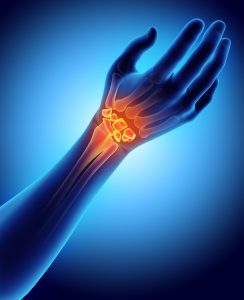Carpal Tunnel Syndrome
WHAT IS CARPAL TUNNEL SYNDROME?
 Carpal tunnel syndrome presents commonly as a source of hand numbness and pain. Carpal tunnel syndrome occurs when the synovial tissues surrounding the flexor tendons in the wrist swell and put pressure on the median nerve as it passes through the carpal tunnel and into the hand. The synovial tissue associated with carpal tunnel, called synovium, lubricates the 9 flexor tendons that pass through the carpal tunnel making it easier to move the fingers. When this swelling of the synovium occurs, it narrows the confined space of the carpal tunnel, putting pressure on the median nerve, and causing loss of proper nerve function. The median nerve provides sensation to your thumb, pointer finger, middle finger, and part of your ring finger.
Carpal tunnel syndrome presents commonly as a source of hand numbness and pain. Carpal tunnel syndrome occurs when the synovial tissues surrounding the flexor tendons in the wrist swell and put pressure on the median nerve as it passes through the carpal tunnel and into the hand. The synovial tissue associated with carpal tunnel, called synovium, lubricates the 9 flexor tendons that pass through the carpal tunnel making it easier to move the fingers. When this swelling of the synovium occurs, it narrows the confined space of the carpal tunnel, putting pressure on the median nerve, and causing loss of proper nerve function. The median nerve provides sensation to your thumb, pointer finger, middle finger, and part of your ring finger.
WHAT CAUSES CARPAL TUNNEL SYNDROME?
Pressure from the synovium onto the median nerve causes the nerve to act sub-optimally. Sensations like pain, burning, tingling, or the pins and needles sensation play into effect due to the compression. The cause of this tissue inflammation can vary in each individuals case, but ultimately do not vary the outcome.
The most common risk factors linked to carpal tunnel are:
- diabetes
- thyroid dysfunction
- high blood pressure
- autoimmune disorder such as rheumatoid arthritis
- fluid retention
- fractures or trauma to the wrist
- females have higher rates of incidence
- pregnancy
- advanced age
- obesity
- smoking
- chronic kidney disease
- alcoholism
WHAT ARE SYMPTOMS OF CARPAL TUNNEL?
Symptoms can vary patient to patient but typically the main symptoms of the nerve compression present in the thumb, pointer, middle, and index finger, causing weakness, numbness, tingling, or pain, that likely will increase in presentation at night causing disruption of sleep. Patients may also have radiating pain and a burning sensation that travels up the arm.
CARPAL TUNNEL DIAGNOSiS AND TREATMENT
DIAGNOSIS OF CARPAL TUNNEL SYNDROME
Orthopedic surgeons, preferably orthopedic hand surgeons, diagnose carpal tunnel after they perform a physical examination, discuss patient history, and possibly perform a nerve conduction study or an EMG. The physical examination allows the physician to give a diagnosis, while the nerve conduction studies and EMGs provide measurable data to quantify aspects of carpal tunnel syndrome. Nerve conduction studies work by measuring nerve impulse over specific regions of possible impingement and calculating the rate of transmission over the distance the test measured. The physician takes a series of measurements and marks the points of interest with a pen on your arm. The physician attaches sensors from your measured regions to their computer that communicate with the instrument that sends series of small electric currents down the nerve. By measuring signal transit time over a specified distance, the physician calculates the rate of nerve conduction. Your physician considers if nerve impulse is slower than normal over the right regions of nerve in their diagnosis of carpal tunnel syndrome. EMG studies work similarly but check the quality of the affected muscles. Electrodiagnostic tests with mild results correlate with higher probabilities of recovery after treatment.
TREATMENT OF CARPAL TUNNEL SYNDROME
Behavioral modification
Many people find that certain movements and aspects of their lives contribute to the progression of symptoms of carpal tunnel syndrome. Repetitive stressors, such as finger movement during typing, or vibrations such as driving, can irritate the internal structures of the wrist and cause inflammation. Changing these behaviors, or making ergonomic changes, often clears up or reduces symptom progression.
Stretching/Physical Therapy
Steroid Injections
Steroid injections either provide temporary relief or no relief of symptoms. Cases that respond well over a short period of time to steroid injections confirm the diagnosis and correlate with positive outcomes after completing treatment.
Surgical Intervention
Endoscopic Carpal Tunnel Release
Variation in surgical approach has little effect in the outcome of the procedure with the main difference falling in the realm of one scar or two smaller scars.
CARPAL TUNNEL SYMPTOMS? CALL TODAY! 817-375-5200
F.A.Q.
How long does it often take for patients to recover from carpal tunnel syndrome fully?
The time it takes to recover from carpal tunnel syndrome is contingent on the severity of the condition and the treatment utilized. In less complex situations, the symptoms could improve after a few weeks of rest and more conservative treatment. Recovery could take a few months or even longer when the condition is more serious.
Can carpal tunnel syndrome be prevented?
There is no foolproof method for preventing carpal tunnel syndrome; however, some things can help lower the risk, including wearing ergonomic equipment, keeping a decent posture, and taking breaks during repeated activities to rest the hands and wrists.


